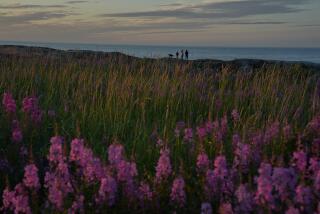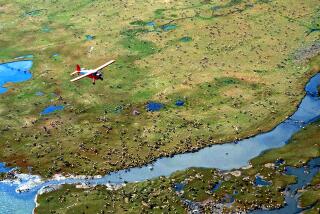Alaska’s Arctic Circle puts nature close and civilization, thankfully, far
Reporting from Kotzebue, Alaska — The Cessna rumbled to life and turned on its balloon tires to position for takeoff. Its engine revved, and the aircraft began to gain speed, racing along the gravel sandbar.
I watched the small plane climb into the sky, slowly disappearing in the distance. In a moment, it was gone.
Our group of 13 was alone on a river inlet, 100 miles north of the Arctic Circle. It would be nearly a week before we saw another sign of civilization.
The surroundings were unlike any I had seen. In August, emerald meadows ambled up to barren hills that climbed to jagged peaks. Blue lakes, surrounded by bright green marshlands, gleamed like sapphires.
Not even the fish seemed normal. Spawning salmon struggled past obstructions in the shallow creek bed, almost crawling over rocks in their relentless journey back to the place where they had hatched. A college student in our party stepped into the water to pick up a fish and cradled it in his arms to carry it to deeper water.
“That made you feel better, but not the fish,” one of our guides said, noting that the creatures were dying around us. They were in the final moments of a multiyear journey that had taken them down the creek to the Kugururok River and eventually into the Arctic Ocean. Now they were returning.
Curious passerby
During the next five days, we were to follow the salmon’s original path down the Kugururok through the roadless 6.5-million-acre Noatak National Preserve. The park is home to the largest remaining wild river system in the country, a place with no dams, docks or maintained river channels. It was to be a leisurely trip, four days to float 35 miles and an extra day to hike into the DeLong Mountains, a collection of rock mounds, wild berry bushes and peaks that stood out against the periwinkle sky.
The trip was organized by Alaska Alpine Adventures, and although it has offered back-country trips for decades, it had never floated this North Slope river. But the timing was appropriate, because although the area seems worlds away from civilization, it is threatened.
The preserve could see temperatures increase 15 degrees by the end of the century, melting permafrost, reducing water levels and fueling wildfires, according to a recent climate study published in the journal Environmental Research Letters. The scenery that amazed me may not be here for long.
Still, it’s not easy to reach. Commercial air service took us as far as Kotzebue, an Alaska Native village of 3,000 on the Chukchi Sea, where we met our charter plane. The operator, Golden Eagle aviation, emblazoned its aircraft with the politically incorrect slogan: “Trust us with your life, not your daughters or wife.”
Like it or not, this was our lifeline. The Cessna could carry only three or four at a time on the hourlong flight, so we were slowly shuttled into the wilderness, each of us getting a chance to marvel at the scenery from the air.
Our party grew with each trip, and we began to set up camp and take in our surroundings, which included clouds of mosquitoes. The insects could bite through wool socks, and we quickly learned that only a netted hat and doses of DEET would keep them at bay.
But there were larger creatures to worry about.
One evening, after a dinner of Asian-spiced noodles, we were sipping whiskey from Nalgene jars when the doctor from Atlanta interrupted our conversation. “Bear!” he called out, pointing across the river.
We swiveled, and there it was: a cinnamon-shaded creature ambling along the shore, perhaps 50 feet away. About the same time, the grizzly noticed it wasn’t alone. Instead of scampering off, it seemed curious, angling closer to the water’s edge — and us.
We had been warned about this. A few weeks before the trip, an email from the owner of Alaska Alpine Adventures announced our guides wouldn’t be bringing guns on the trip.
The risk from bears was remote, he said, assuring us that a few simple practices would keep us safe. It was imperative, we were told, to make noise whenever we walked through the brush. Everyone had developed a ditty to alert potential predators of our presence. My favorite, from the only high schooler on the trip, was a singsongy chant that almost invited the carnivore to join her on the next verse.
We also had been briefed about how to use bear spray, a can of mace that was part of the toilet kit each of us carried when it was time to visit the trench we used as a bathroom.
“Make sure you don’t spray it upwind,” Matt, one of our guides, warned us. I was dubious, wondering whether a 600-pound predator would be deterred by what felt like an oversize can of Raid.
And now, we were going to see how an animal reacted to us.
The bear was fascinated. Matt and Tina, our second guide, led our party to the river across from him. “Git!” she yelled, waving her arms over her head. We joined in, adding to the racket. The predator took notice but continued to peer at us as it slipped into the brush.
Although it was our closest encounter, we also had seen bears from the water, including a cub and mother, which was none too pleased as we floated by in our royal blue inflatable canoes.
Bears were not the only challenge. Our boats, heavy with gear, were tricky to maneuver. Although the river presented few large rapids, the current flowed swiftly. Nearly all of us had moments when the boat would begin to spin and we found ourselves floating backward, perhaps a fitting way to see such an Alice in Wonderland landscape.
Skipping stones
Given our northerly location, it never really got dark, even in mid-August. The sun would disappear about midnight, setting to the north and reappearing slightly to the east a few hours later. Even at 3 a.m., it was light enough to read in my tent, and I never used my flashlight during the trip.
Without the structure of day and night, there was no real rush. We would start our day leisurely, slowly breaking camp and packing our gear. We would launch our canoes sometime after noon and float for a few hours before pulling ashore for lunch.
Indeed, life on the Kug was uncomplicated. Pastimes were as simple as skipping stones or throwing little rocks at big rocks. When a plane buzzed over one morning, I looked up idly, realizing it was my only confirmation that the outside world was still functioning. Otherwise, without cell service, let alone internet, there was no way to tell.
Not that we lacked distractions. During one break, our conversation was interrupted by a caribou bull, a hulking mammal that looked the size of a small Toyota.
Once again, it wasn’t following the script I had come to expect from wildlife, which is to be spooked by humans and to scurry away. Instead, the ungulate strutted in our direction. When he was directly in front of us, he turned its body to display a commanding rack of antlers.
I understood instinctively that he was showing his size and vigor, challenging our group or at least putting us in our place.
The region’s quarter-million caribou are legendary. During annual migrations, thousands swim across the Noatak River. One was intimidating enough.
A buzz from the sky
Our last day of paddling took us to the confluence of the Noatak River, a wider and more powerful waterway. We set up camp near a gravel field formed where the rivers met. A plane was supposed to meet us the next morning, but the wind picked up and we wondered whether an aircraft could land.
Secretly, I hoped not.
But after breakfast we heard a buzz, and the Cessna emerged from the sky. The moment it touched down, I could feel our adventure coming to a close. In an hour or two, we would be back in Kotzebue, a town with internet and news alerts bringing the crush of civilization to this remote corner of the Arctic.
The Kugururok already felt like a distant memory.
If you go
THE BEST WAY TO ANCHORAGE
From LAX, Alaska offers nonstop service to Anchorage, and Delta, Alaska, United and American offer connecting service (change of planes). Restricted round-trip airfare from $242, including taxes and fees.
Alaska Alpine Adventures, alaskaalpineadventures.com. Our August outing was offered as an exploratory scouting trip to a new area. The outfitter will set up a similar excursion if requested. The $6,000 cost included air transportation from Anchorage, all food, tents, canoes and guides.
For information on visiting the Noatak National Preserve and the other federal lands in the Western Arctic, visit nps.gov/noat.
More to Read
Sign up for The Wild
We’ll help you find the best places to hike, bike and run, as well as the perfect silent spots for meditation and yoga.
You may occasionally receive promotional content from the Los Angeles Times.






